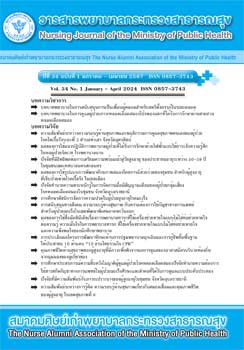บทบาทพยาบาลในการสนับสนุนการเป็นเพื่อนผู้คลอดสำหรับสตรีตั้งครรภ์ในระยะคลอด
Main Article Content
บทคัดย่อ
สตรีตั้งครรภ์ในระยะคลอดโดยเฉพาะครรภ์แรก มักเกิดความวิตกกังวล กลัว เครียดและเจ็บปวดจากการรอคลอด และการคลอด ส่งผลให้ผู้คลอดและครอบครัวเกิดประสบการณ์ที่ไม่ดีต่อการคลอดตามธรรมชาติ การส่งเสริมให้มีเพื่อนผู้คลอดในระยะคลอดเป็นทางเลือกหนึ่งที่นิยมแพร่หลายในต่างประเทศและพยาบาลมีบทบาทสำคัญที่จะสนับสนุนให้มีเพื่อนผู้คลอดเกิดขึ้น โดยพยาบาลต้องแจ้งและอธิบายรายละเอียดถึงวิธีการเตรียมตัวของสตรีตั้งครรภ์และครอบครัว ตั้งแต่ในระยะตั้งครรภ์ เพื่อให้สตรีตั้งครรภ์มีเวลาตัดสินใจเลือกผู้ที่จะเป็นเพื่อนผู้คลอดในขณะคลอด ทั้งนี้ผู้ที่ถูกเลือกเป็นเพื่อนผู้คลอดต้องมีความรู้พื้นฐานเกี่ยวกับการเปลี่ยนแปลงในแต่ละระยะของการเจ็บครรภ์ และการคลอด ต้องเตรียมตัวไปพร้อมกับสตรีตั้งครรภ์เพื่อให้สามารถช่วยเหลือดูแลได้ถูกต้องเหมาะสม โดยพยาบาลในระยะฝากครรภ์และระยะคลอด ต้องมีบทบาทในการสนับสนุน ส่งเสริมให้เพื่อนผู้คลอดเตรียมตัวเพื่อทำหน้าที่สำคัญในการสนับสนุนด้านข้อมูล สนับสนุนการปฏิบัติกิจกรรม สนับสนุนทางอารมณ์ และ เป็นผู้ผสานความเข้าใจ ซึ่งจะทำให้เกิดประโยชน์คือ สร้างความอบอุ่นใจให้กับผู้คลอด และลดภาระงานพยาบาลในห้องคลอดด้านการช่วยเหลือผู้คลอดโดยเฉพาะทางด้านอารมณ์ ในปัจจุบันโรงพยาบาลของรัฐส่วนใหญ่ ยังไม่อนุญาตให้ญาติเฝ้าคลอด ความกลัวที่กล่าวมาข้างต้นทำให้สตรีตั้งครรภ์และครอบครัวเลือกวิธีการผ่าตัดคลอดเพิ่มมากขึ้น ดังนั้น การเตรียมเพื่อนผู้คลอดโดยเริ่มต้นตั้งแต่ระดับนโยบายของสถานบริการ เตรียมพยาบาลให้เข้าใจบทบาทในการสนับสนุนการเป็นเพื่อนผู้คลอดรวมถึงการนำหลักฐานเชิงประจักษ์มาใช้ร่วมกับการดำเนินก็จะส่งผลถึงความสำเร็จของการมีเพื่อนผู้คลอดได้และอาจช่วยลดค่าใช้จ่ายในระบบบริการสุขภาพด้วย
Article Details

อนุญาตภายใต้เงื่อนไข Creative Commons Attribution-NonCommercial-NoDerivatives 4.0 International License.
บทความและรายงานวิจัยในวารสารพยาบาลกระทรวงสาธารณสุข เป็นความคิดเห็นของ ผู้เขียน มิใช่ของคณะผู้จัดทำ และมิใช่ความรับผิดชอบของสมาคมศิษย์เก่าพยาบาลกระทรวงสาธารณสุข ซึ่งสามารถนำไปอ้างอิงได้
เอกสารอ้างอิง
Xuto P. Women during labour and postpartum periods. 2 ed. Chiangmai: N.P.T Printing; 2020.
Tongsong T. Obstetrics. 6th ed. Chiang Mai: Department of Obstetrics and Gynecology Faculty of Medicine Chiang Mai University; 2021.
Senanayake H, Wijesinghe RD, Nayar KR. Is the policy of allowing a female labor companion feasible
in developing countries? Results from a cross sectional study among Sri Lankan practitioners. BMC Pregnancy and Childbirth. 2017;17(1):392.
Sethi R, Gupta S, Oseni L, Mtimuni A, Rashidi T, Kachale F. The prevalence of disrespect and abuse during
facility-based maternity care in Malawi: evidence from direct observations of labor and delivery. Reproductive Health. 2017;14(1):111.
Bohren MA, Hofmeyr GJ, Sakala C, Fukuzawa RK, Cuthbert A. Continuous support for women during
childbirth. Cochrane database of systematic reviews. 2017(7).
Dubey K, Sharma N, Chawla D, Khatuja R, Jain S. Impact of birth companionship on maternal and fetal
outcomes in primigravida women in a government tertiary care center. Cureus. 2023;15(5):e38497.
Bohren MA, Berger BO, Munthe Kaas H, Tunçalp Ö. Perceptions and experiences of labour companionship:
a qualitative evidence synthesis. Cochrane Database of Systematic Reviews. 2019(3).
World Health Organization. Sexual, reproductive, maternal, newborn, child and adolescent health:
Policy survey, 2018-2019: Summary report [internet]. 2020 [cited 10 January 2024]. Avialable from:
https://www.who.int/publications/i/item/9789240004092
WHO Session. Journal of Obstetrics and Gynaecology Research. 2023;49(S1):87-9.
World Health Organization. The prevention and elimination of disrespect and abuse during facility-based
childbirth: WHO statement. World Health Organization [internet]. 2014. [cited 10 January 2024]. Avialable from: https://www.who.int/publications/i/item/WHO-RHR-14.23
Rungreangkulkij S, Ratinthorn A, Lumbiganon P, Zahroh RI, Hanson C, Dumont A, et al. Factors
influencing the implementation of labour companionship: formative qualitative research in Thailand.
BMJ open. 2022;12(5):e054946.
Tanglakmankhong K. Mismatch between childbirth expectations and childbirth experiences among
Thai Women. Journal of Health Science. 2017;20(3):525-32.
Kabakian Khasholian T, Bashour H, El Nemer A, Kharouf M, Elsheikh O, Group LCS, et al. Implementation
of a labour companionship model in three public hospitals in Arab middle income countries. Acta Paediatrica. 2018;107:35-43.
Munkhondya BMJ, Munkhondya TE, Chirwa E, Wang H. Efficacy of companion-integrated childbirth
preparation for childbirth fear, self-efficacy, and maternal support in primigravid women in Malawi. BMC
Pregnancy and Childbirth. 2020;20(1):48.
World Health Organization. Companion of choice during labour and childbirth for improved quality
of care: evidence-to-action brief [internet]. 2020 [cited on 10 January 2024]. Available from:
https://www.who.int/publications/i/item/WHO-SRH-20.13
De Mucio B, Binfa L, Ortiz J, Portela A. Status of national policy on companion of choice at birth in
Latin America and the Caribbean: Gaps and challenges. Revista Panamericana de Salud Pública
;44:e19.
Kabakian-Khasholian T, Portela A. Companion of choice at birth: factors affecting implementation.
BMC pregnancy and childbirth 2017;17(1):1-13.

